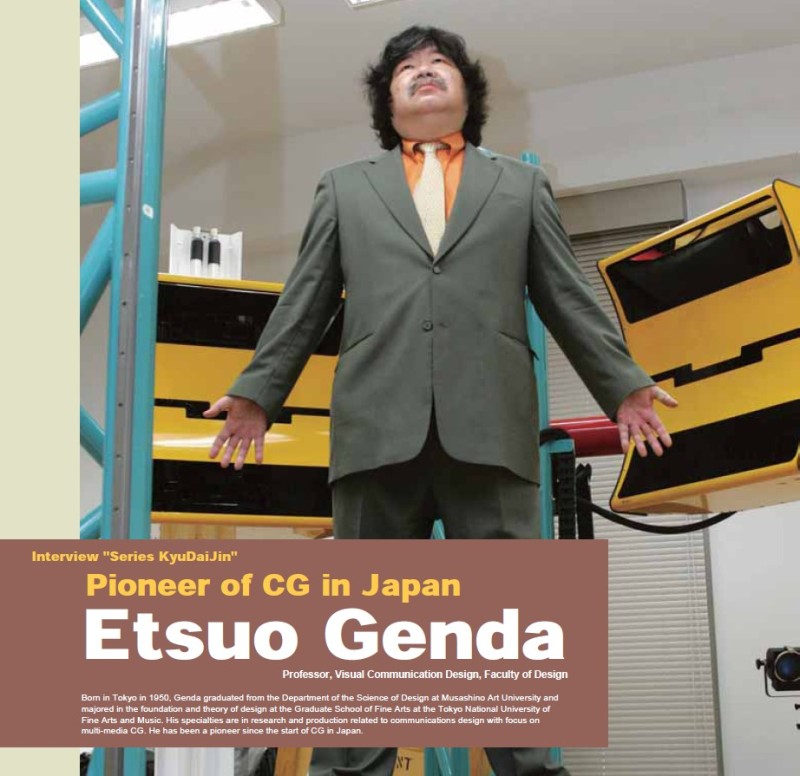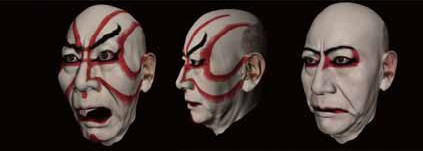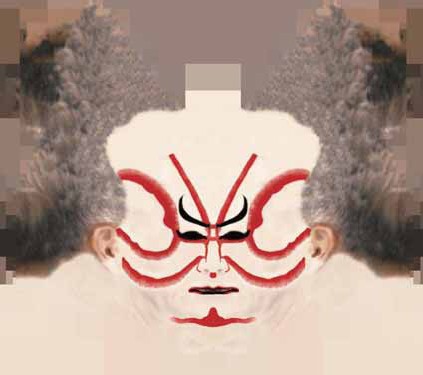Recently, Kyushu University was selected as a base to promote the development of human resources in the image contents industry as a cutting-edge, digital-contents creation support unit, funded by the Science and Technology Promotion Grant of the Ministry of Education, Culture, Sports, Science and Technology in 2005. This project aims at developing content creators and researchers that have advanced artistic sense against the background of theoretical ideas. Making use of linkages with businesses and the university's comprehensive cooperative agreements, this is part of an approach to concentrate digital industries, such as the gaming industry in Fukuoka, by developing image content creators with experience in computer graphics (CG), animation, and game software, with collaboration between industries, academia, and the local government. Steering the project is one of the leading authorities on Japanese digital art, Professor Etsuo Genda. Together with Professor Genda is Ms. Ji-Young Choi, an international student from Korea, who was awarded the grand prize at "EUROGRAPHICS 2005." An interview with Ms. Choi is on page 16.
- First, I would like Professor Genda to tell us about your journey to become an authority on digital art. What was the opportunity that set you on this road?
Genda: The period I was in university in the 1970s was one of high economic growth and was a time when technological advances were reviewed in a new light upon reflection of various problems. A new educational structure came into existence during this period with a renewed relationship between art and science, as was seen at the Kyushu Institute of Design (now, Kyushu University, School of Design) which advocated this time to "humanize technology."
I was interested in the Kyushu Institute of Design when it was created; however, it was after all a science-oriented university. I, who was humanities-focused, chose the Department of the Basic Design at Musashino Art University, which was founded one year before the Kyushu Institute of Design in 1967 with a similar objective to that of the institute. The subjects in this department tried to catch the connection of design specialties across the areas of art and technology with a fresh approach focusing on the "integration of each field with design as its foundation," rather than "learning about the foundations of design." Here, the subjects of study set forth by Kimimasa Abe and Shutaro Mukai, among others, were novel-not only sensibility-oriented studies related to design, but also semiotics, phase theory, cybernetics, information theory, and ergonomics, among others-and were positioned as the background of logical ideas, which art universities could not have conceived in those days. These subjects widely caught the idea of design. These experiences had a strong influence on my current ideas of design.
- How did you spend your school days?
Genda: I had an interest in computer graphics (CG) from an early age; however, that was a time when universities did not have computers. The only one that could be used was in the Industrial Product Research Institute of the Ministry of International Trade and Industry (now the Ministry of Economy, Trade and Industry) of the Industrial Science and Technology Agency (now the National Institute of Advance Industrial Science and Technology). Mr. Eiichi Idehara who was chief of the design section at that time (and is currently a professor of art and technology at Hokkaido Tokai University) formed a research circle and allowed the research students to use the only graphic computer for research in Japan. That is where we learned about programming and design evaluation methods.
There were numerous opportunities to meet with and gain knowledge from many people in the group such as Mr. Yoichiro Kawguchi, a professor at Tokyo University; Mr. Tsuchiro Takahashi, now President of Tama Art University; Mr. Tomohiro Ohira, currently a professor at Musashino Art University; and Mr.Katsuhiko Nishi who founded ASCII. All of them are now at the forefront of the CG industry. It was a different source of education from what we received at school to develop human resources.
- When did you start to get a taste for "science as entertainment?"
After I finished graduate school I taught part-time at universities and was also involved in developing exhibition plans for pavilions at the Tsukuba Science Expo, including the Automobile, Matsushita, and Governmental pavilions, as well as production of plans for the digital planetarium and of computer graphics.
In addition, I also established a laser design company and produced laser graphics for concerts and events for Eikichi Yazawa (Japanese rock musician) and The Tulips (Japanese folk-rock band). |
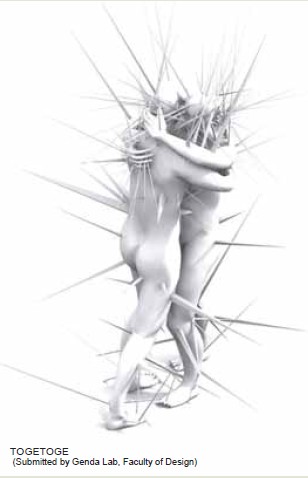 |
- So since that time you have had the concept of marketing
cutting-edge art.
I have had an interest in this since that time. At that time, turning laser and computer art into images and productions was still in experimental stages; and trying to market this as a product was, if I think about it now, a visible integration of art with cutting-edge technology.
- The "Advanced, Digital Contents Creation SupportUnit," which received recognition from the Ministry of Education, Culture, Sports, Science and Technology, is based on the premise of creating art backed by logic. Can you tell us a little about the meaning and background of this project?
In earlier courses, I would put out a problem, such as "On your computer screen, draw a Shimeji mushroom and Enokidake mushroom using the same algorithm." It can be done by using simple functions; however, students cannot do this at all. Even if they learn difficult mathematics, physics or advanced programming at university, they are not able to do basic functions such as drawing a simple image that is in their head on their computer screens. What they learn at university is not connected to real-life contents production and art.
Therefore, contrary to what most people think, I think that a person's ability to express him or herself can be expanded further by bringing logical ideas into fields where artistic sensibility is required, in the background of media technology.
Then I think if we utilize evaluations of man's sensibility and develop concepts that capture entertainment as science, this will become a new area of research and will become an industry in which Japan can show to the world.
- What do you think of the positioning of the digital contents industry?
Genda: I am enthusiastic about taking action to create an industry cluster in Kyushu with an eye firmly fixed on Asia. Developing the basis for the industry is critical. We should have the spirit that this area does not just subcontract to Tokyo; Kyushu can be a center for developing world-level industries.
There are many international students from Asia who wish to study digital contents. Considering the fact that most of them, after returning to their own countries, are involved in teaching, I think that it is possible for Kyushu University to set and disseminate the standard for Asian education in the future.
- Would you elaborate on what kind of education you have in mind?
Genda: A curriculum has three pillars: mathematical principles and moulding, observation of targets and artistic expression, and conceptualization of contents. Since our products are eventually marketed, artists have to have a clear and strategic understanding for intellectual property rights and their application as creators. This is accomplished through gaining practical experience by
joint projects with businesses, such as long-term internships.
- I hear that you are thinking about establishing a venture company on campus to market the products and ideas that arise from the educational and research process.
Genda: My idea has changed from when I first thought of it; however, in the future, I will consult with the intellectual property department at the university, and will establish a limited liability partnership, and gather funds for materializing the intellectual property, ideas and know-how arisen from this university. This fund would be similar to the idol fund and film fund schemes. This is a plan that would allow students to set up their own businesses with the fund as their financial resource, and aim towards developing an industry in Kyushu. Dissemination of the outcomes of education as intellectual property, returning it back once again to education, and developing an independent financial base: these are the achievements of the education that I am pursuing.
- This is a concept which will lead to the independence of the university.
Genda: I think that this can become a unique field that characterizes Kyushu University as one that ties together the cutting edge knowledge and artistic sensibility of the university and gives concrete shape to contents. The most important point is having this take root as local industry. Even with support from the national government to develop superior human resources, if the outcome is not returned to the local area, there is no meaning in doing this initiative. It cannot be carried out as a five-year program of the Ministry of Education, Culture, Sports, Science and Technology and end there.
- Professor Genda, one of your favorite students, Ms. Choi (P16), received the grand prix award recently.
Genda: Her work, "Samulnori," which is the traditional theater of Korea, arose as part of the research on digital archives. It encompasses the idea of what CG can do in order to hand down traditional techniques and movements to the following generations.
- Finally, do you have a message for the students at Kyushu University and those at the School of Design?
Genda: I would like to tell them to be like DaVinci. He was an artist and a scientist, as well as a designer at times. He had a great thirst for knowledge and interest in human beings and in medicine. I want to tell you to be like him, with the ability to work in many fields as a specialist and upon that, be a creator. Become a superman who can do anything with high artistic sensibility-I want to help you to develop yourselves so that you can be active at the global level.
I welcome participation of students from other schools as well, not only the students at the School of Design. After being accepted in the graduate school, you can take part in any unit in any department. I will work with students to let them realize their full potential as contents creators or researchers who will be leaders of their age in games, CG, and imaging.

|
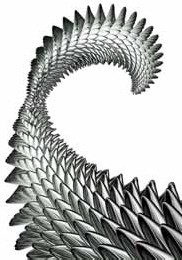
|

|
||
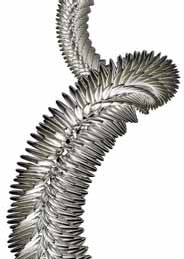
|

|
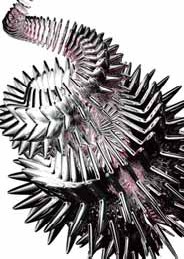
|
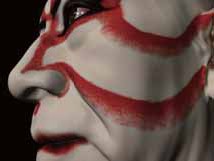 |
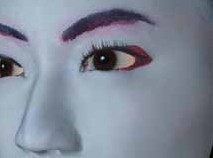 |
|
MATAYANU (Submitted by Genda Lab, Faculty of Design) |
(Submitted by Genda Lab, Faculty of Design) |
Previous PageTop Next
